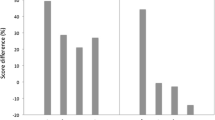Summary
Single unit recordings of primary auditory fibers ofTeleogryllus oceanicus show responses to frequencies over the range 0.5 kHz to 42 kHz. The characteristic frequencies (ChFs) of units were distributed over much of the bandwidth investigated although few units were recorded with ChFs below 4 kHz or in the region 7 kHz to 10 kHz. Some units showed more than one peak of sensitivity and others were broad-banded with no tuning to a particular frequency. Units whose ChFs approximated to the carrier frequency (CF) of the proclamation song were the most highly tuned. The majority of units had a tonic response pattern and were not spontaneously active. The implications of these findings are discussed.
Similar content being viewed by others
Abbreviations
- ChF :
-
characteristic frequency
- CF :
-
carrier frequency
References
Coles RB, Lewis DB, Hill KG, Hutchings ME, Gower DM (1980) Directional hearing in the Japanese quail (Coturnix coturnix japonica). II. Cochlear physiology. J Exp Biol 86:153–170
Dambach M (1972) Der Vibrationssinn der Grillen I. Schwellenmessungen an Beinen frei beweglicher Tiere. J Comp Physiol 121:281–304
Dambach M (1976) Der “Vibrationssinn” bei Grillen. Umschau 76:683–684
Eibl E (1978) Morphology of the sense organs in the proximal parts of the tibiae ofGryllus campestris L. andGryllus bimaculatus deGeer (Insecta, Ensifera). Zoomorphology 89:185–205
Eibl E, Huber F (1979) Central projections of tibial sensory fibers within the three thoracic ganglia of crickets (G.campestris L.,G. bimaculatus DeGeer). Zoomorphologie 92:1–17
Esch H, Huber F, Wohlers DW (1980) Primary auditory neurons in crickets: Physiology and central projections. J Comp Physiol 137:27–38
Hill KG (1974) Carrier frequency as a factor in phonotactic behaviour of female crickets (Teleogryllus commodus). J Comp Physiol 93:7–18
Hill KG, Boyan GS (1977) Sensitivity to frequency and direction of sound in the auditory system of crickets (Gryllidae). J Comp Physiol 121:79–97
Hill KG, Lewis DB, Hutchings ME, Coles RE (1980) Directional hearingin the Japanesequail (Coturnixcoturnixjaponica) I. Acoustic properties of the auditory system. J Exp Biol 86:135–151
Kalmring K, Lewis DB, Eichendorf A (1978) The physiological characteristics of the primary sensory neurons of the complex tibial organ ofDecticus verrucivorus L. (Orthoptera, Tettigonioidae). J Comp Physiol 127:109–121
Moiseff A, Pollack GS, Hoy RR (1978) Steering responses of crickets to sound and ultrasound: Mate attraction and predator avoidance. Proc Natl Acad Sci USA 75:4052–4156
Nocke H (1972) Physiological aspects of sound communication in crickets (Gryllus campestris L.). J Comp Physiol 80:141–162
Popov AV, Shuvalov VF (1977) Phonotactic behaviour of crickets. J Comp Physiol 119:111–126
Popov AV, Shuvalov VF, Markovich AM (1975) Spectrum of the calling songs, phonotaxis and the auditory system in the cricketGryllus bimaculatus. (In Russian). J Evol Biochim Physiol 2:453–460
Rheinlaender J (1975) Transmission of acoustic information at three neuronal levels in the auditory system ofDecticus verrucivorus (Tettigoniidae, Orthoptera). J Comp Physiol 97:1–53
Rheinlaender J, Kalmring K, Popov AV (1976) Brain projections and information processing of biologically significant sounds by two large ventral-cord neurons ofGryllus bimaculatus DeGeer (Orthoptera, Gryllidae). J Comp Physiol 110:251–269
Taylor MR (1978a) Trapeziodal waveform generator. New Electronics 11 (3):20
Taylor MR (1978b) Synchronized tone burst generator. New Electronics 11 (20): 20
Young D, Ball E (1974) Structure and development of the auditory system in the prothoracic leg of the cricket,Teleogryllus commodus (Walker). I. Adult structure. Z Zellforsch 147:293–312
Zaretsky MD (1972) The neurophysiological and behavioural mechanism of the response to intra-specific acoustical signals in crickets. Ph D Thesis, University of California
Zaretsky MD, Eibl E (1978) Carrier frequency-sensitive primary neurons and their anatomical projection to the central nervous system. J Insect Physiol 24:87–95
Zhantiev RD, Tschukanov VS (1972) Frequency characteristics of tympanal organs of the cricketGryllus bimaculatus deGeer (Orthoptera, Gryllidae). Vestn MGU, Ser VI 2:3–8
Author information
Authors and Affiliations
Additional information
We thank Mr. P. Foster for techninical help.
Rights and permissions
About this article
Cite this article
Hutchings, M., Lewis, B. Response properties of primary auditory fibers in the cricketTeleogryllus oceanieus (Le Guillou). J. Comp. Physiol. 143, 129–134 (1981). https://doi.org/10.1007/BF00606076
Accepted:
Issue Date:
DOI: https://doi.org/10.1007/BF00606076




